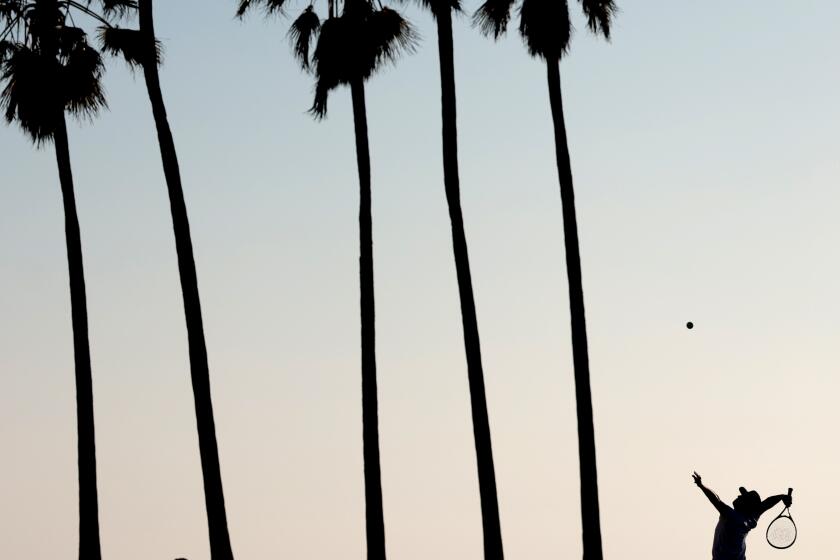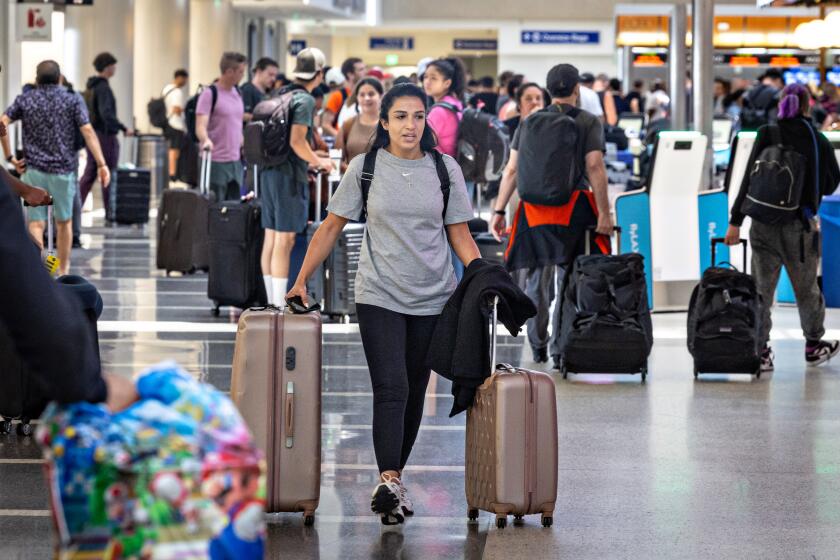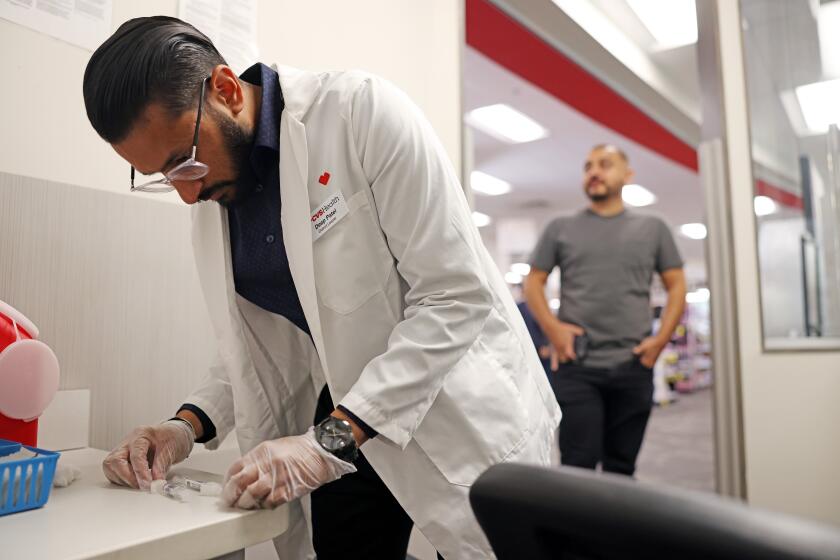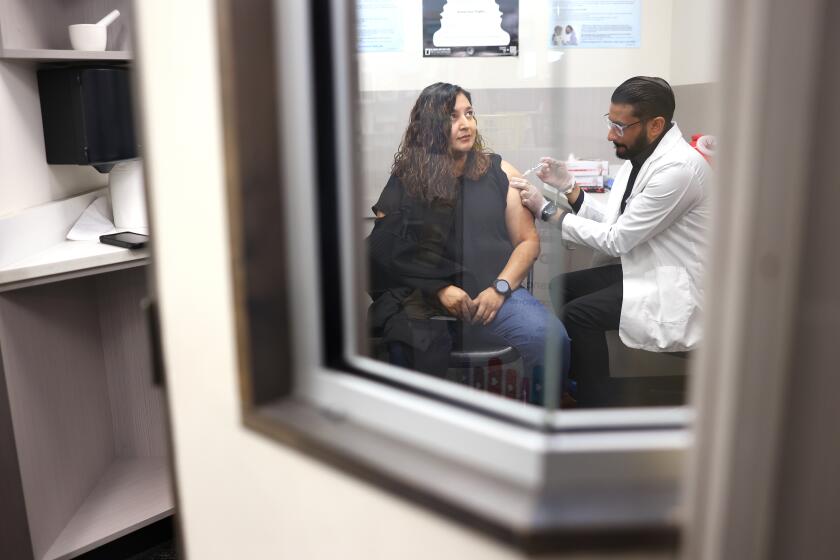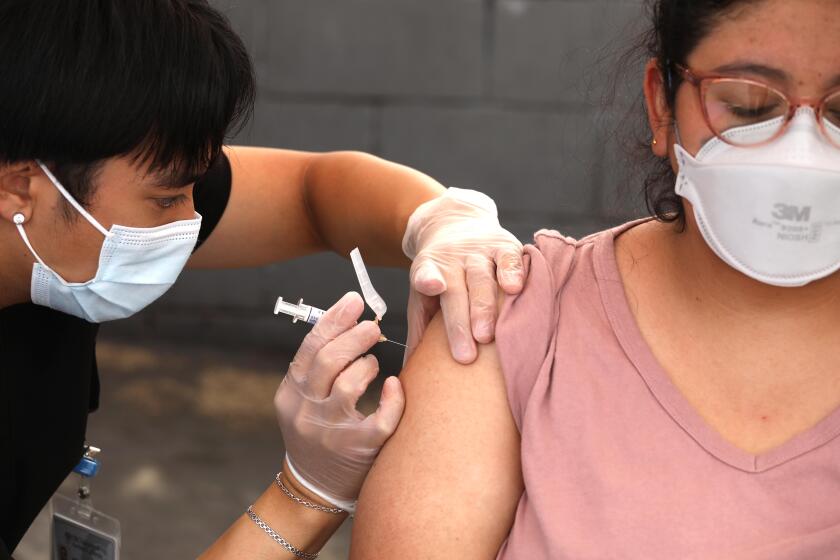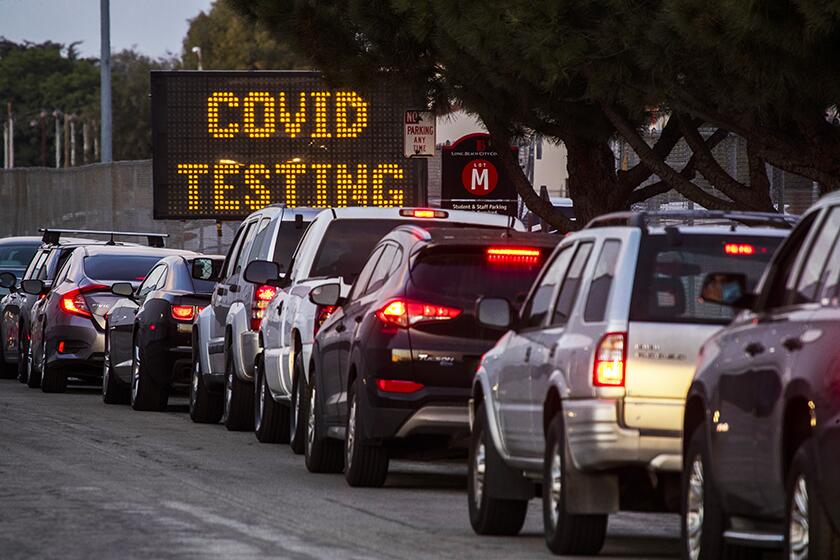This was a ‘prime weekend’ for COVID spread in California. Why experts see a ‘real risk’ ahead

- Share via
With COVID remaining at stubbornly high levels in California, some doctors are warning that transmission could again accelerate following the busy Labor Day holiday weekend — potentially prolonging a summer wave that has already proved more intense and enduring than some experts had anticipated.
Doctors will be closely monitoring the data for any signs of a post-holiday bump, which could materialize due to a few factors. First, Americans were expected to hit the road or take to the skies in potentially record-breaking numbers this year and, with COVID transmission elevated across most of the country, there’s a not-insignificant risk of exposure.
Second, the coronavirus has continued to mutate in ways that have allowed it to spread more readily from person to person.
“People are not just back to pre-pandemic — it’s even more than I think before the pandemic happened, in terms of travel,” said Dr. Elizabeth Hudson, regional chief of infectious diseases for Kaiser Permanente Southern California.
“So that does mean that there’s real risks of getting in contact with someone else who has COVID,” she said. And with many California schoolchildren having already returned to school, “this is, unfortunately, a prime weekend to potentially come down with something.”
COVID’s spread is being aided by people who are still going to work or traveling while sick. Doctors say it’s important for people who are sick to avoid putting others at risk.
California is one of 47 states with “high” or “very high” coronavirus levels in wastewater, the U.S. Centers for Disease Control and Prevention said Friday. That’s also the case in the District of Columbia.
The Transportation Security Administration previously projected that the past holiday weekend would end up being the busiest Labor Day travel period on record, with more than 17 million people expected to be screened at airports over the seven-day period ending Wednesday.
“A lot of people that I know get COVID actually coming back from a trip,” said Dr. Peter Chin-Hong, an infectious diseases specialist at UC San Francisco. “Be prepared for the possibility that those sniffles or symptoms after coming back will be COVID.”
He said it’ll be especially important for those at higher risk — such as seniors age 65 and older and immunocompromised people — to get tested. If positive, they should promptly seek early antiviral therapy like Paxlovid, especially if they haven’t been vaccinated in the past year.
At UCSF’s hospitals, people hospitalized with COVID are generally in their 70s and 80s and haven’t gotten a vaccine within the last year, Chin-Hong said.
The rate at which coronavirus tests are coming back positive continues to rise in California.
California and the nation have endured a significantly longer COVID wave this summer than last. California has spent 12 weeks with “high” or “very high” coronavirus levels in wastewater since June, with more likely to come. For all of last summer, California recorded eight weeks with “high” coronavirus levels in sewage, but never reached “very high” levels.
A big reason for this surge in infections has been the spread of ever-more contagious subvariants, each with unofficial monikers referencing the particular mutations that give them an evolutionary advantage over preceding strains.
May saw the emergence of the FLiRT strains, which have since given way to FLuQE (pronounced fluke) and, most recently, deFLuQE (pronounced de-fluke).
The dominant version of the coronavirus now is KP.3.1.1. That subvariant, which has the deFLuQE mutations, was estimated to make up 42.2% of coronavirus samples nationwide for the two-week period ending Saturday, up from 19.8% a month ago, according to the CDC.
Doctors and scientists are keeping an eye on yet another coronavirus subvariant — XEC — that could surpass the latest hyperinfectious strain.
COVID hospitalizations and deaths have ticked up this summer, but remain far lower than in previous waves thanks to lingering immunity against severe disease from past immunizations and infections.
For the week that ended Aug. 10, 881 COVID deaths were reported nationally — more than twice as many as the first week of summer.
In L.A. County, the average number of daily COVID deaths jumped to 2.9 for the week ending Aug. 6, the most recent available. Prior to that, L.A. County had been reporting roughly one to two COVID deaths per day since early July.
There are signs in some parts of the country that coronavirus transmission may have crested. But we’ve been fooled before, some doctors warn.
The CDC says September and October are generally the best times for most people to get a COVID shot, though there are other factors to consider.
The CDC has designated California as one of nine states where COVID-19 is thought to be “declining” or “likely declining,” according to data published Friday.
But it will take time to know if that trend holds up. Earlier this summer, COVID in California was for a week classified as being “stable or uncertain,” only for transmission to worsen yet again.
“In the past, you know, four to eight weeks, we have done this thing where we sort of crested, and then a couple weeks later, the numbers started to go up again,” Hudson said. “So this is a real sort of wild-factor time. We don’t really know which direction things are going to go.”
Circumstances — “the confluence of Labor Day and the kids being back in school” — could conspire to push transmission rates higher, Hudson said. And stubborn summer heat could further exacerbate things by keeping people inside in places without good air circulation, a ripe setting for COVID to spread.
The Los Angeles County Department of Public Health said it will take more weeks of data “before knowing if we’ve passed this summer peak.”
In L.A. County, coronavirus levels in sewage were 86% of last winter’s peak over the 10-day period that ended Aug. 17, roughly unchanged from earlier in the month. For the week that ended Aug. 25, an average of 410 coronavirus cases were reported daily, down from the prior week and well below the summer peak of 484.
Doctors urge people who are experiencing respiratory problems to see a medical professional who can check their symptoms and test to determine what their illness is.
Coronavirus cases are certainly an undercount, as they don’t factor in tests done at home or the fact that fewer people are testing at all. But the trends are still useful in determining the trajectory of the wave.
The percentage of emergency room visits in L.A. County that are related to the coronavirus has remained relatively level over the past three weeks — hovering between 3.9% and 4.3%. The latter figure is the highest of the season so far. Last summer’s peak was 5.1%.
The statewide rate at which coronavirus tests are coming back positive is continuing to rise. For the week that ended Aug. 26, 13.7% of reported coronavirus tests in California were positive, up from 11.7% a month earlier. The latest figure has surpassed the peaks from both last winter and last summer.
Chin-Hong said the COVID wave started earlier in California and the West, and he suspects the state has indeed reached the crest. COVID has “basically infected many of the people it would’ve infected. ... We will see more infections during Labor Day for sure, but [it will] probably not continue to go up.”
People with symptoms do not need to have tested positive for the coronavirus to be considered for a diagnosis of long COVID, a new report says.
At UCSF’s hospitals, as of Friday, there were eight coronavirus-positive admitted patients — about the same as in the late spring. At the height of the summer peak, around three or four weeks ago, there were roughly 30, Chin-Hong said.
To combat the spread of COVID, doctors urge those who feel ill to stay home and away from others. And if you do feel sick, you should test.
You might still have COVID-19 even if your first rapid test result is negative, however. Doctors advise testing once a day, or once every other day, through the fifth day after the onset of symptoms.
For those who might still be traveling, wearing masks in indoor settings — like planes and airports — can also help reduce the risk of getting infected.
The updated COVID-19 vaccine could be available any day, a promising development for California and the nation amid a potent and enduring summer wave of the disease.
The CDC recommends everyone age 6 months old and older get vaccinated for the 2024-25 season, ideally in September or October.
COVID-19 vaccines from Moderna and Pfizer were authorized by the U.S. Food and Drug Administration on Aug. 22, and doses were already widely available the following week. On Friday, the FDA authorized the updated seasonal vaccination formula from Novavax, which is made using older, protein-based technology.
For some people, Novavax may be an attractive alternative to the Moderna and Pfizer mRNA vaccines. The mRNA vaccines are somewhat more likely than Novavax or other protein-based vaccines to cause side effects such as a swollen arm and low-grade fever, according to Hudson.
But Novavax’s vaccine for the 2024-25 season was designed against an older subvariant, JN.1, whereas Moderna and Pfizer were designed against KP.2, a more recent subvariant that is more closely related to KP.3.1.1.
Time will tell how this season’s Novavax formula ultimately compares with Moderna and Pfizer, “but you know, it’s still a very good option,” Hudson said.
California’s strongest summer COVID wave in two years is still surging, fueled in part by the rise of a particularly hyperinfectious FLiRT subvariant known as KP.3.1.1.
For those who are interested in Novavax, given that there are only a few differences between JN.1 and KP.2, “I feel very confident that it will give people very good protection,” Chin-Hong said.
As for the side effects that can sometimes come with getting the Moderna or Pfizer COVID vaccinations, they typically don’t last more than a day, and they tend to be relatively mild — far gentler than what a COVID illness can bring, Hudson said. Only about 25% of people who get those vaccines tend to get more pronounced side effects like sore arm and a low-grade fever, Hudson said.
Some doctors suggest scheduling your COVID vaccination when you will have time to rest afterward.
COVID vaccinations are already widely available at stores like CVS, Walgreens, Rite Aid, Vons, Albertsons, Pavilions and Safeway. Health systems like Kaiser Permanente and Sutter Health are poised to offer the shots by mid-September.
For uninsured or underinsured residents, the L.A. County Department of Public Health will eventually offer free doses through its public health clinics and multiservice vaccination sites. “We are awaiting our supply from the manufacturers, but hope to have these at the sites in the next couple of weeks,” the agency said — namely, later in September.
Officials also said that the California Department of Public Health will receive additional funding to make free COVID vaccine doses available for uninsured and underinsured adults. The state is expected to make those vaccines available for ordering in October. L.A. County officials said it’s likely the inoculations will be made available to healthcare providers who have previously offered free COVID vaccines.
Last year, uninsured adults were able to get free vaccines through the federal Bridge Access Program, where people could get immunized at federally qualified health centers, as well as CVS and Walgreens. The Bridge Access Program ended in late August.
More to Read
Sign up for Essential California
The most important California stories and recommendations in your inbox every morning.
You may occasionally receive promotional content from the Los Angeles Times.
